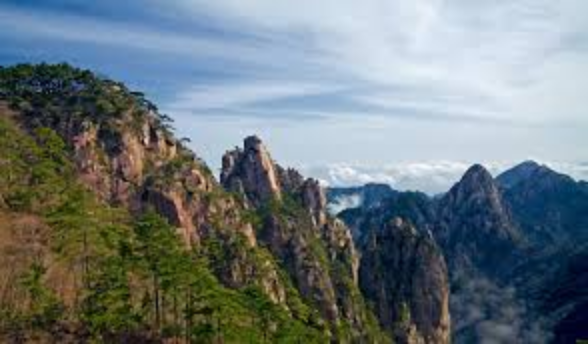
Why is Mount Huangshan Famous?
Mount Huangshan, often described as the “loveliest mountain of China”, has played an important role in the history of art and literature in China since the Tang Dynasty around the 8th century. It was then that a legend dated from the year 747 described the mountain as the place of discovery of the long-sought elixir of immortality, forever linking the mountain with Taoism and magical practices.
But the mountain’s fame is far more extensive than this association. Here we will delve into the multifaceted reasons why Mount Huangshan continues to captivate hearts and minds worldwide.
Natural Beauty
Standing tall in southern Anhui province, Mount Huangshan, literally meaning "Yellow Mountain", is a UNESCO World Heritage Site renowned for its breathtaking natural beauty.
Unique Pine Trees
One of the most iconic features of Mount Huangshan is its unique pine trees. Twisted and gnarled by centuries of wind and weather, these resilient trees cling precariously to the cliffs and peaks, their silhouettes etched against the sky. Some of the most famous pines have been given poetic names like "Welcoming Guest Pine" and "Black Tiger Pine," each with its own unique character and legend.
| Pine Tree Name | Description |
|---|---|
| Welcoming Guest Pine (迎客松) | Located on the eastern side of Jade Screen Peak, this iconic pine tree is known for its welcoming gesture, as if extending a branch to greet visitors. |
| Black Tiger Pine (黑虎松) | Standing tall near the Cloud Valley Temple, this pine tree is named for its dark bark and imposing presence, resembling a crouching tiger. |
Spectacular Rock Formations
The mountain's granite peaks, often shrouded in mist, take on fantastical shapes that have inspired countless poems and paintings. These weathered granite peaks, sculpted by millennia of erosion, rise dramatically from the landscape, often piercing through the cloud cover. Some of the most notable formations include:
| Rock Formation Name | Description |
|---|---|
| Lotus Peak (莲花峰) | The highest peak on Mount Huangshan, resembling a blooming lotus flower. |
| Bright Summit Peak (光明顶) | The second highest peak, offering panoramic views of the surrounding landscape. |
| Flying-Over Rock (飞来石) | A massive boulder perched precariously on a cliff edge, appearing as if it had flown in from the heavens. |
Hot Springs
Nestled amidst the mountain's slopes are numerous natural hot springs, renowned for their therapeutic properties. These springs offer respite to weary travelers and are believed to possess healing powers due to their mineral-rich waters.
Cultural Significance
Beyond its natural splendor, Mount Huangshan holds immense cultural significance in China.
Influence on Art and Literature
For centuries, the mountain has been a muse for artists and poets, who have sought to capture its ethereal beauty and mystical aura. From the delicate brushstrokes of traditional Chinese ink paintings to the evocative verses of ancient poems, Mount Huangshan has left an indelible mark on Chinese art and literature.
Taoist Heritage
As mentioned, Mount Huangshan has deep roots in Taoism. Numerous temples and monasteries dot the mountainside, serving as places of worship and retreat for Taoist practitioners seeking enlightenment amidst the serenity of nature.
Tourism and Recreation
Today, Mount Huangshan is a popular tourist destination, attracting millions of visitors annually from around the globe.
Hiking Trails
Well-maintained hiking trails crisscross the mountain, offering a range of options for all skill levels, from leisurely walks to challenging climbs.
Cable Car Access
For those seeking a more comfortable ascent, cable cars provide breathtaking views as they glide effortlessly up the mountain slopes.
Photography Hotspots
With its ever-changing vistas, Mount Huangshan is a photographer's paradise, offering endless opportunities to capture the interplay of light, mist, and granite. Whether it's the sunrise over a sea of clouds or the silhouette of a lone pine tree against the twilight sky, the mountain presents countless moments of awe-inspiring beauty waiting to be immortalized.
FAQs
1. What is the best time to visit Mount Huangshan?
The best time to visit Mount Huangshan is during the spring (April-May) or autumn (September-October) when the weather is mild and sunny. These seasons offer the best chances of clear skies for stunning views. However, each season offers a unique perspective of the mountain's beauty.
2. How long does it take to explore Mount Huangshan?
To fully appreciate the beauty of Mount Huangshan, it's recommended to allow for at least two to three days. This will give you enough time to explore the main peaks, hike the scenic trails, and soak in the breathtaking scenery.
3. Are there accommodations available on Mount Huangshan?
Yes, there are a variety of accommodation options available on Mount Huangshan, including hotels, guesthouses, and hostels. It is recommended to book accommodations in advance, especially during peak season.
note: This return of all, without the author's permission, may not be reproduced